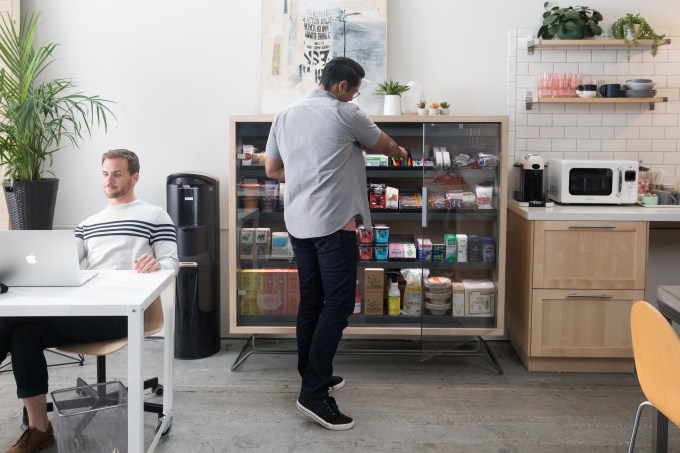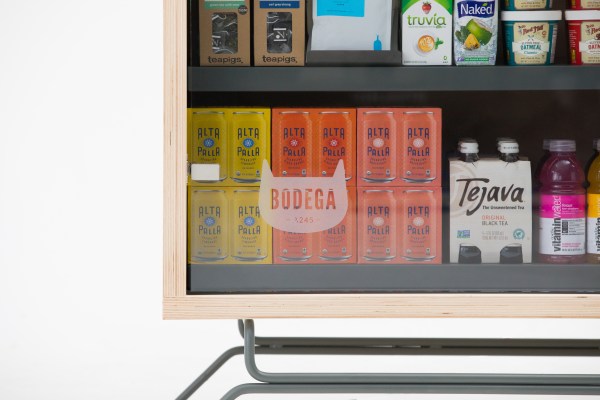If you’re in a big city like New York City, you’re probably used to walking around the block away from where you live to the corner shop and picking up a jug of milk or some dishwashing detergent.
But Paul McDonald (who says he has not lived in New York), who was at Google for more than 13 years, wants to collapse that distance between walking to that store to pick something up and ordering it online even further. A new startup called Bodega hopes to install kinds of convenience store-like kiosks right into apartment buildings, gyms, or other infrastructure that’ll sell the goods — like dish detergent — that residents need. The company has raised $2.5 million in a financing round led by First Round Capital and Homebrew Ventures and has 30 bodegas live scattered around the Bay Area.
“Retailers are contouring their business around this fact that users want convenience,” McDonald said. “There’s really only been two options: you can go to the store, or you can order something online. What we’re trying to do is introduce a third option, a new way of buying things. Shrink the store, bring the best parts in a smaller form factor and bring it to where you are.”
Bodega will, of course, have to go up against the typical corner stores in cities, which at this point are iconic within their various neighborhoods with their quirks — and sometimes their cats. And as they look to woo office buildings and gyms, those organizations may already have vending machines and stores internally and have spent time building up those relationships. (The Bodega in your apartment building, also, probably won’t remember your favorite weekend sandwich order even two years after you’ve moved away.)
The whole process starts with a small kiosk that sits inside a building filled with goods. Bodega uses an array of cameras to see who’s walking up to the kiosk. They open up that kiosk with a three-digit password and then grab something out of it. The cameras then isolate their hand and what they are picking up, and when they walk away with that product Bodega logs it as sold to that customer. The customer’s credit card is charged, and then life moves on.
Bodega then tracks which goods were sold, who’s buying what, and then predicts over time which products they should place in the bodega. It gets filled up periodically, and then people come and buy their once-a-week purchases again when needed. McDonald said Bodega uses off-the-shelf hardware for its cameras, meaning it should be easier to deploy rather than create something custom. And, thanks to advances in image recognition, companies like Bodega can theoretically finally get off the ground.
Bodega starts with a base set of products whenever it strikes a deal with a location to put a new kiosk down. Over time, the company refines that set of products based on what people are and are not purchasing. Bodega will query its users periodically to ask what’s missing after their second or third trip over to the kiosk. All this is in an attempt to try to shave off everything that’s unnecessary in the buying process — space, travel, and so on — to something that’s a more streamlined experience.

“Retail in The U.S. is huge, 10% of Americans work in retail,” McDonald said. “The folks who are retailers want technology to reduce their costs and bring products closer [to consumers]. The market we’re going after is some combination of the grocery, gym market, and everyday essentials. Eventually, what we see is a world where you don’t have to go to the 30,000 square foot stores. Instead, we distribute the store based on products you buy once a week or month.”
McDonald actually said getting their kiosks into apartment buildings and gyms is one of the easier parts of the pitch, as apartment buildings are always looking for new amenities in order to attract tenants. But that makes sense in a kind of urban sprawl like New York City, where living in an apartment building is normal and its tenants might find something like this genuinely useful outside of walking to the actual store on the corner.
This also might make sense with new, modern apartment buildings — but in a lot of cities, you’ll find yourself apartment hunting in older buildings and dealing with landlords that know they won’t need these perks. Your building might not even have laundry in it, much less the room for a kiosk like this. While it might help the newer buildings attract higher rents from more affluent tenants, it’s not clear if this will become as prolific as McDonald hopes.
